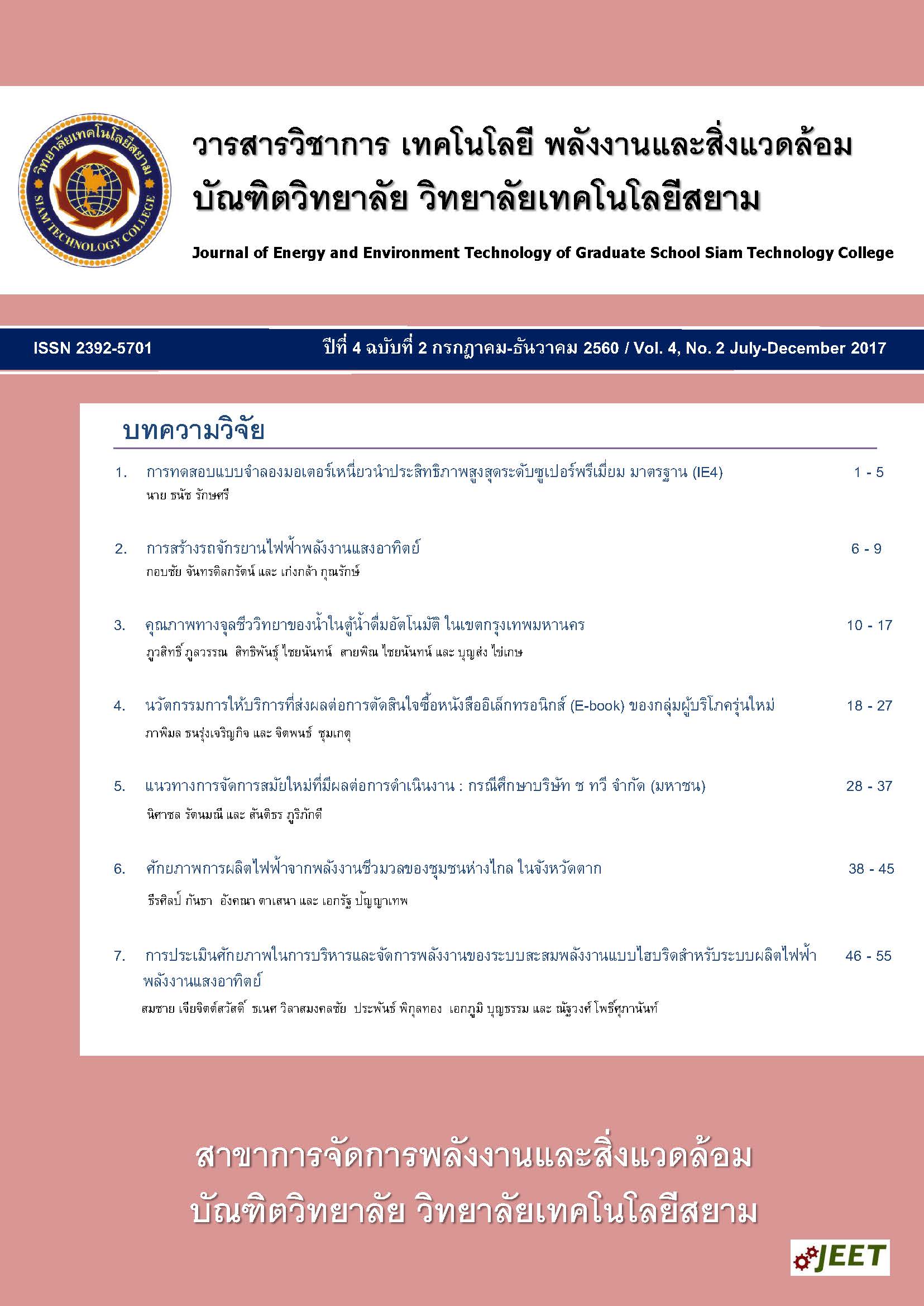POTENTIAL EVALUATION ON ENERGY MANAGEMENT OF HYBRID ENERGY STORAGE FOR SOLAR POWER SYSTEM
Main Article Content
Abstract
Electricity production from solar energy is usually affected by the environment, which causes the produced electricity unstable. This instability of the electricity creates a fluctuation of transmission line and decreases the efficient use of the electricity. An energy storage system has been used to reduce the environmental effect, but the initial cost of the system is high, especially for lithium-ion batteries (Li-ion) having high performance, expensive cost, and no production in the country. Thus, it causes a barrier to driving the wide usage of the batteries in the country. A hybrid energy storage system is a co-operation between lithium-ion batteries (Li-ion) and valve regulated lead acid battery (VRLA). The system has cheaper initial cost and can be produced in the country. The system control is used for management in order to extract the different characteristics of the batteries for maximum performance. From the results of basically potential evaluation on energy management of hybrid battery system, the problem and limitation of the system were known and could be improved for various types of buildings. The hybrid energy storage could efficiently reduce the electricity consumption from the grid during high electricity demand. Thus, it reduced the energy expense. When considering the stability of energy from solar energy, it was found that the energy storage system can reduce the energy fluctuation even though there is high energy demand as energy usage in the office. This study results will further be compared with the testing results in laboratory.
Article Details
เนื้อหาและข่อมูลในบทความที่ลงตีพิมพ์ในวารสารวิชาการ เทคโนโลยี พลังงาน และสิ่งแวดล้อม บัณฑิตวิทยาลัย วิทยาลัยเทคโนโลยีสยาม ถือเป็นข้อคิดเห็นและความรับผิดชอบของผู้เขียนบทความโดยตรง ซึ่งกองบรรณาธิการวารสารไม่จำเป็นต้องเห็นด้วย หรือว่าร่วมรับผิดชอบใด ๆ
บทความ ข้อมูล เนื้อหา รูปภาพ ฯลฯ ที่ได้รับการตีพิมพ์ในวารสารวิชาการ เทคโนโลยี พลังงาน และสิ่งแวดล้อม บัณฑิตวิทยาลัย วิทยาลัยเทคโนโลยีสยาม ถือเป็นลิขสิทธิ์ของวารสารวิชาการ เทคโนโลยี พลังงาน และสิ่งแวดล้อม บัณฑิตวิทยาลัย วิทยาลัยเทคโนโลยีสยาม หากบุคคล หรือหน่วยงานใดต้องการนำทั้งหมด หรือส่วนหนึ่งส่วนใดไปเผยแพร่ต่อ หรือเพื่อกระทำการใด ๆ จะต้องได้รับอนุญาต เป็นลายลักษณ์อักษรจากวารสารวิชาการ เทคโนโลยี พลังงาน และสิ่งแวดล้อม บัณฑิตวิทยาลัย วิทยาลัยเทคโนโลยีสยาม เท่านั้น
References
[2] การไฟฟ้าฝ่ายผลิตแห่งประเทศไทย, 2560, ความต้องการพลังไฟฟ้าสูงสุด, (ออนไลน์). แหล่งที่มา : http://www.egat.co.th/index.php?option=com_content&view=article&id=348&Itemid=116. 8 มิถุนายน 2560
[3] S.J. Chiang, S.C. Huang, C.M. Liaw, 1995, Three-phase Multifunctional Battery Energy Storage System, IEE Proc.-Electr. Power Appl., Vol. 142, No. 4, pp. 275-284.
[4] M.J.M. Davis, and P. Hiralal, 2016, Batteries as a Service: A New Look at Electricity Peak Demand Management for Houses in the UK. Procedia Engineering, 145: pp. 1448-1455.
[5] A. Mishra, D. Irwin, P. Shenoy, and T. Zhuz, 2013, Scaling Distributed Energy Storage for Grid Peak Reduction, ACM e-energy.
[6] S. Son and H. Song, 2014, Real-Time Peak Shaving Algorithm Using Fuzzy Wind Power Generation Curves for Large-Scale Battery Energy Storage Systems, International Journal of Fuzzy Logic and Intelligent Systems, pp. 305-312.
[7] J. Neubauer and M. Simpson, 2015, Deployment of Behind-The-Meter Energy Storage for Demand Charge Reduction, NREL Technical Report.
[8] F.A.T. Al-Saedi, 2013, Peak Shaving Energy Management System for Smart House, International Journal of Computer Science Engineering and Technology (IJCSET), Vol. 3, No. 10, pp. 359-366.
[9] European Commission Joint Research Centre in cooperation with frontier Economics, 2009, Electricity storage in the power sector.
[10] S.M. Schoenung and W.V. Hassenzahl, 2003, SANDIA national laboratory: Long- vs. Short-Term Energy storage Technologies Analysis - A Life-Cycle Study, A study for the DoE Energy storage Systems Programme, Report reference: SAND2003-2783.
[11] L. Beurskens, 2003, Analysis in the Framework of the Investire network - Economic performance of storage technologies, ECN-C--03-132.
[12] J. Eyer and G. Corey, 2010, SANDIA national laboratory: Energy Storage for the Electricity Grid Benefits and Market Potential Assessment Guide A Study for the DOE Energy Storage Systems Program, Report reference: SAND2010-0815.
[13] T. Bocklischh, 2015, “Hybrid energy storage systems for renewable energy applications”, Energy Procedia, Vol. 73, pp. 103 – 111.
[14] N. Mukherjee and D. Strickland, 2015, "Control of Second-Life Hybrid Battery Energy Storage System Based on Modular Boost-Multilevel Buck Converter," IEEE Transactions on Industrial Electronics, Vol. 62, No. 2, pp. 1034-1046.
[15] H. Arita, et. al., 2015, “Large Format Hybrid Energy Storage System for Power Leveling”, Hitachi Chemical Technical Report, No. 57, pp. 20-21.
[16] C. Rahe, 2016,“Lead-acid Batteries and Lithium-ion Batteries in parallel Strings for an Energy Storage System for a Clinic in Africa”, Proceedings of the 20th International Scientific Student Conferenece, Prague.
[17] Jia-Ying Ye, Kun Ding, Thomas Reindl, Armin G. Aberle, 2013, Outdoor PV Module Performance under Fluctuating Irradiance Conditions in Tropical Climates, In Energy Procedia, Vol. 33, pp. 238-247.


